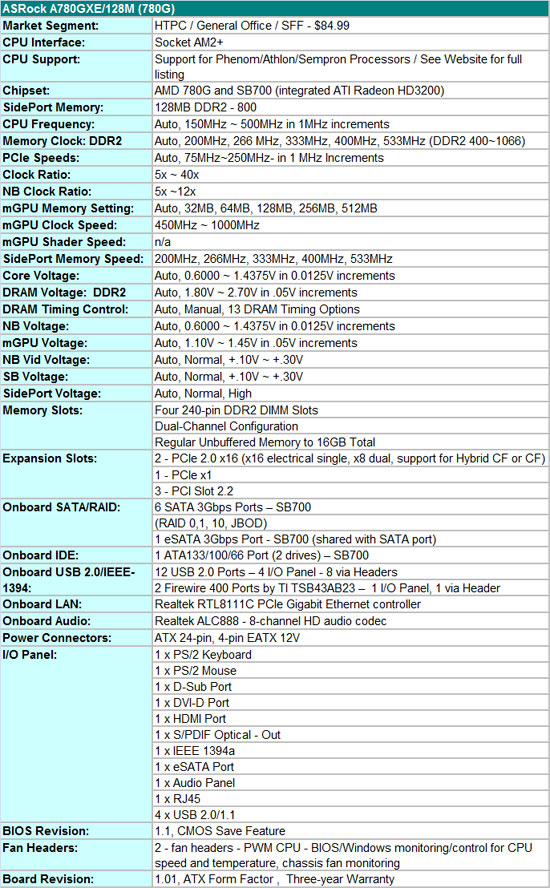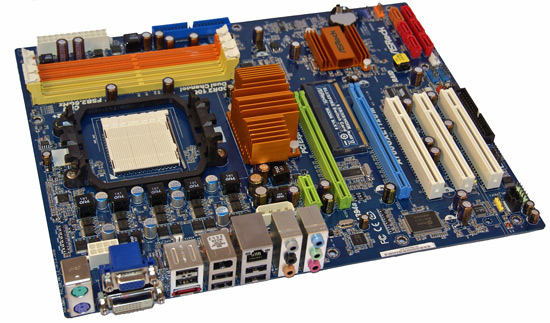The IGP Chronicles Part 2: AMD 780G vs. Intel G45 vs. NVIDIA GeForce 8200
by Gary Key on October 14, 2008 12:40 PM EST- Posted in
- Motherboards
AMD 780G: ASRock A780GXE/128M
The third board in today’s chipset overview is from ASRock. ASRock is typically associated with the low-end market and for offering products based on previous generation chipsets. ASRock has changed considerably over the past year and now offers current generation chipsets, premium features, unique designs, and they are starting to open up to overclocking.
While their marketing (visit the website link above) might be a little over the top for some, their product designs are starting to really impress us based on value/performance criteria. In fact, expect to see a slew of ASRock products reviewed over the coming weeks as we concentrate on the under $150 market space.

The board we are looking at today is the ASRock A780GXE/128M that features the AMD 780G chipset, SB700 Southbridge, and is paired with 128MB of DDR2 Sideport memory. Offered in an ATX format, the A780GXE/128M provides 2 physical x16 PCIe slots (x8 in dual-slot configuration or single x16 operation only), three PCI slots, and a single x1 PCIe connector. Due to the configuration, you can run x8 CF or Hybrid CF on the board. In fact, up the mGPU core clock to 700MHz and you have a 790GX board for $85.

The board also features the Realtek 8111C for Gigabit LAN, Realtek ALC888 for HD audio, TI based IEEE 1394a support, and RAID 0, 1, 10, and JBOD operation. An eSATA port is offered but it means sharing with another SATA port off the SB700. Two video selections are available, VGA or DVI-D output (with HDMI coming via a dongle).
The overclocking options in the BIOS are extensive for a 780G board and nearly match those of the Gigabyte MA780PM-D2SH. We had no problems overclocking a variety of processors on this board and the results matched those of more expensive boards as we will see shortly. The AMD 780G chipset also topped out around 250HTT when utilizing the IGP unit.
The board features an excellent 5-phase power system along with quality capacitors. We clocked our 9950BE up to 236HTT, 8750 at 243HTT, and the 4850e at 245HTT with base memory clock set to DDR2-800 with 5-4-4-15 settings. The mGPU clock reached 750 MHz before we noticed graphical corruption in several game titles. In addition, when overclocking via HTT, we dropped our Sideport memory clock to 400MHz to ensure stability. We had some luck setting Sideport voltage to high and leaving the SP memory speed at 533MHz (1066) up to 225 HTT.
CrossFire operation worked perfectly with two of our Sapphire HD4670 cards and matched the performance of the 790GX boards. We did not need to utilize the additional Molex power connector until we connected two HD4850 cards. Hybrid CF worked fine with an HD3450 card.
Pros/Cons
This is a unique board from ASRock as the features and options place it in direct competition with the 790GX boards for a budget level price of $85. We are still completing overclock testing with the 9950BE and HD4850 setup, but so far the board has held up for over a 100-hour period without a problem. Performance is equal to most of the 790GX boards with a discrete GPU and the same for the IGP unit when it is clocked to 700 MHz.
We did find a couple of drawbacks on this board. The color scheme is just not for us and it eerily reminds of a Gigabyte board. However, color does not equate to performance pitfalls. The PCIe x1 slot only works with half-length cards. A native HDMI port is missing although the DVI-D port fully supports HDCP. We had hoped that ASRock would have utilized their ALC890 HD audio chipset, but that and a DVI-HDMI converter is what basically separates this board and their upper market 790GX product. Finally, only two fan headers on an ATX board designed for the home market is unacceptable today.
Overall, the A780GXE/128M is a unique product offering in the 780G market and an excellent value at $85. This is a board that is a little quirky at times and might not be perfect, but maybe that is the reason why we like it so much. As such, we highly recommend this board for those looking for 790GX performance at a 780G price.















41 Comments
View All Comments
duploxxx - Tuesday, October 14, 2008 - link
nice review, gives a clear ups and downs from each part. there's off course always a reason to recommend an intel part in your conclusion even if you brake it to the ground in the earlier pages....this time you took power consumption, which was one part you would already know from the moment you made your base specs. however for a basic htpc people don't buy quadcores, they buy dual's.put a 4850e on the plate against e5200 and start all over again, i'am sure you will get a whole other conclusion and 0 reasons to ever buy a s775 platform for htpc in stead you would pick the nvdia/amd offerings with am2 chipset.
npp - Tuesday, October 14, 2008 - link
I suspect the E5200 system would be faster at the end - running at equal clock speeds Core 2 CPUs tend to faster than the old Athlons (at least I think so). I'm not sure what goes for the power consumption, but I really don't understand why one should care about that, anyway. Decent coolers are all around and saving the planet by cutting off some 20-30-50W from your bill is simply ridiculous. As long as we're talking of numbers around the 100W mark, anything goes.strikeback03 - Tuesday, October 14, 2008 - link
Anandtech has seemed to favor quad-cores for transcoding duties in past HTPC articles.harshaflibbertigibbet - Tuesday, October 14, 2008 - link
I hope you will also be reviewing the much delayed and finally launched NVIDIA GeForce 9300/9400 chipsets for the Intel platform. In my opinion, they would end up being the best solution for HTPC users.Badkarma - Tuesday, October 14, 2008 - link
Hi Gary,I read through your article which is very good btw. However, I couldn't find what driver versions you were using to test with. Sorry if I just missed it.
Golgatha - Tuesday, October 14, 2008 - link
I have a HTPC running an Intel E8400 C2D, Zalman 9500 HSF, 6GB RAM, a passively cooled ATI 2600 Pro 256MB, Lite-On SATA Blu-ray/HD DVD combo optical drive, Abit IP35-E, 3 hard drives (250GB and 2x750GB), 380w Earthwatts PS, 4 fans (this includes the PS and CPU fan), and a HT Omega Striker 7.1 discreet sound card. The system runs Vista 64bit Home Premium.My requirements for a HTPC were for it to be out of sight (tucking it behind the entertainment center and using a Bluetooth Logitech DiNovo Mini works great for me), run cool and quiet, and not use much electricity. Running 2xFolding@Home clients, a Tversity server for my PS3, and playing a Blu-ray movie uses about 115w system power for the entire system (measured with a kill-a-watt brand device).
I think the configurations tested weren't really representative of how folks build their HTPC, unless you're assuming it's a do-it-all type of PC, which isn't really a HTPC at that point IMO?
Why in the world would a dedicated HTPC need a quad core CPU or a 520w PSU? Dual core 45nm parts are more than capable of even the most demanding tasks. Also, a 520w PSU for a 100-150w system is completely inefficient.
http://www.anandtech.com/casecoolingpsus/showdoc.a...">http://www.anandtech.com/casecoolingpsus/showdoc.a...
Also, barebones motherboards are cheaper than their IGP counterparts by at least $15-$20 (my Abit board was $70 after MIR), which gives a bit of leeway to purchase a $30-$50 dedicated video card that will give a much better end user experience at the end of the day. Also, when something better comes out (hey, I'm interested in AMD's new 4550 etc. series too), you don't have the unnecessary components on the motherboard sucking electricity.
fic2 - Tuesday, October 14, 2008 - link
That is exactly what I don't understand about the recent "HTPC" articles on here. For some reason they think that people actually use quad monster processors for HTPCs. I got a $25 BE-2400 45W cpu that I intend to use in an HTPC, not some 125W beasty thing that triples my power usage.androo - Wednesday, October 15, 2008 - link
I totally agree! HTPCs are for the living room and should make little to no noise. 140W CPUs have no place in such a rig. Save that for a gaming rig that goes in the bedroom or den (especially if your wife is a light sleeper!).tonyintoronto - Wednesday, October 15, 2008 - link
I don't get it either. HTPC in my opinion are to be low power systems, dedicated to movies, music and TV... Doesn't make any sense to me to see 3x and quad cores tested. I use a AMD 4450E and i'm already way "oversized", that processor can play all formats of HD running at 1.1GHZ w/out any issues together with a cheap asus 3450 card. That and the gaming performance, who in they right mind would game with integraded graphics? its like showing to 1/4 mile race with a horse and carriage.I do agree with them, the 780G and G45 are poor excuses for HTPC boards, IMHO the cheapest possible board with ati 4650 or 4670 makes the most sense. Don't get me started on those 550W power supplies :)
Mathos - Wednesday, October 15, 2008 - link
No idea why they used quad core, other than the fact that a quad would spend more time in low power mode and have lower CPU usage than a dual. That and there are no AMD dual cores out yet that use HT 3.0, although the x2 6500 should be. Most of the AMD based boards are adversely effected by using an older X2 instead of something that uses HT3.0.Anyone not seeing the point of a 780g/790gx board, or an nForce 8200/8300 board for an HTPC is not thinking. The point is to not need a discrete card. Many HTPC's use low profile cases, which make finding an adequate video card difficult. Not to mention with the 780g/790gx you can later install a $50 discrete 3650 or 3450 and run it in Xfire with the IGP for better gaming performance. Same goes for the lower end 8000 and 9000 cards on the nforce chipset.
As far as the PSU goes it leaves room for possibly adding in a discrete card later. Also remember that most PSU's are most effecient at around 50% load which happens on some of the AMD systems under heavy load. Not to mention if you want to have a silent PSU you need to keep the load low so the fan isn't humming constantly, which would happen on a lower rated PSU.